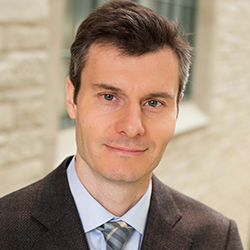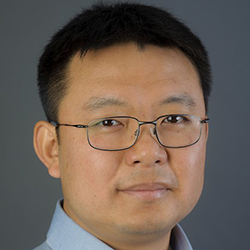Backman and Zhang Paper Wins PNAS Cozzarelli Prize
Winning paper reports the discovery of blinking DNA
A paper by Northwestern Engineering’s Vadim Backman and Hao Zhang has received the Cozzarelli Prize from the Proceedings of the National Academy of Sciences (PNAS). Each year, PNAS gives the award to a recently published paper of outstanding scientific excellence and originality.
 The paper, “Superresolution intrinsic fluorescence imaging of chromatin utilizing native, unmodified nucleic acids for contrast,” was among six papers published in 2016 to receive the Cozzarelli Prize. Luay M. Almassalha, a graduate student in Backman’s laboratory, and Biqin Dong, a postdoctoral fellow in Cheng Sun’s research group, served as the paper’s co-first authors. Sun, associate professor of mechanical engineering, also contributed to the work.
The paper, “Superresolution intrinsic fluorescence imaging of chromatin utilizing native, unmodified nucleic acids for contrast,” was among six papers published in 2016 to receive the Cozzarelli Prize. Luay M. Almassalha, a graduate student in Backman’s laboratory, and Biqin Dong, a postdoctoral fellow in Cheng Sun’s research group, served as the paper’s co-first authors. Sun, associate professor of mechanical engineering, also contributed to the work.
The winners will be recognized during the PNAS Editorial Board Meeting and the National Academy of Sciences Annual Meeting Awards Ceremony on April 30, 2017 in Washington, D.C.
“PNAS is a unique interdisciplinary journal that has a very important mission at the cutting edge of the dissemination of research,” said Backman, Walter Dill Scott Professor of Biomedical Engineering. “We are privileged to be among the select group of authors recognized by this award.”
In Backman and Zhang’s award-winning paper, they report watching DNA blink — something that had never been seen before. For decades, textbooks stated that macromolecules within living cells do not fluoresce on their own. Technology instead relies on special, yet toxic, fluorescence dyes to enhance contrast when macromolecules are imaged.
 The Northwestern Engineering team, however, discovered that macromolecule structures in living cells do naturally fluoresce. The phenomenon was never seen before because the molecules were in the “dark state,” a condition in which they do not absorb or emit light. But just because they spend so much time in the dark state does not mean they never emit light. Backman and Zhang found that when illuminated with visible light, the molecules were excited and lit up well enough to be imaged without fluorescent stains. And when excited with just the right wavelength, the molecules lit up better than they would with the best, most powerful fluorescent labels.
The Northwestern Engineering team, however, discovered that macromolecule structures in living cells do naturally fluoresce. The phenomenon was never seen before because the molecules were in the “dark state,” a condition in which they do not absorb or emit light. But just because they spend so much time in the dark state does not mean they never emit light. Backman and Zhang found that when illuminated with visible light, the molecules were excited and lit up well enough to be imaged without fluorescent stains. And when excited with just the right wavelength, the molecules lit up better than they would with the best, most powerful fluorescent labels.
Backman and Zhang’s discovery could open the next frontier of biological discovery by paving a new way for label-free, super-resolution nanoscopic imaging and expanding the understanding of biological processes. Researchers will also be able to image the active processes in living cells more accurately without fluorescent dyes, as the toxic dyes cause the cells to die immediately after their application.
“The paper reports on a new label-free, super-resolution microscopy technology that allows unprecedented insights into the native structure of biological cells,” said Zhang, associate professor of biomedical engineering. “Super-resolution microscopy is a fast growing field with potential ranging from advances in fundamental biology to diagnostic and therapeutic medicine.”